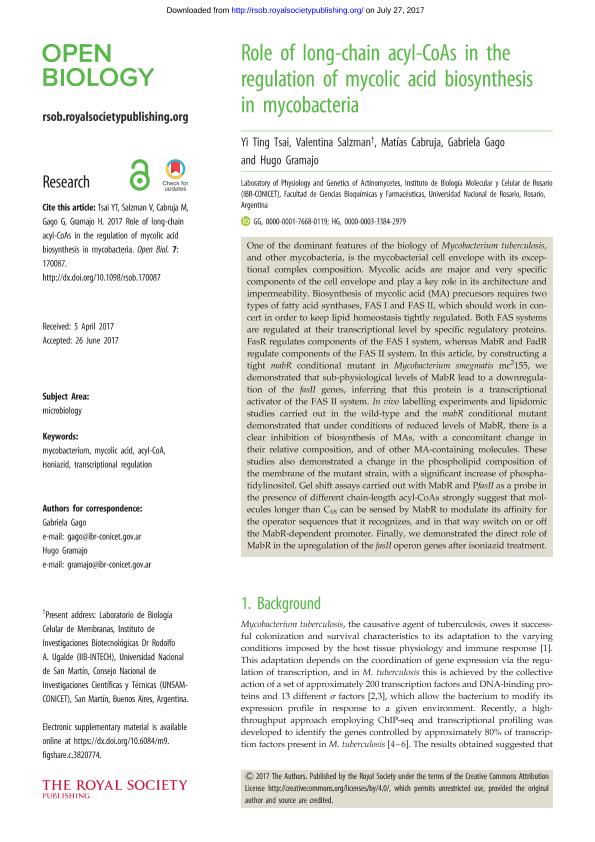Mostrar el registro sencillo del ítem
dc.contributor.author
Tsai, Yi Ting

dc.contributor.author
Salzman, Valentina

dc.contributor.author
Cabruja, Matias Ezequiel

dc.contributor.author
Gago, Gabriela Marisa

dc.contributor.author
Gramajo, Hugo Cesar

dc.date.available
2018-11-28T19:43:28Z
dc.date.issued
2017-08
dc.identifier.citation
Tsai, Yi Ting; Salzman, Valentina; Cabruja, Matias Ezequiel; Gago, Gabriela Marisa; Gramajo, Hugo Cesar; Role of long-chain acyl-CoAs in the regulation of mycolic acid biosynthesis in mycobacteria; The Royal Society; Open Biology; 7; 7; 8-2017; 1-15; 170087
dc.identifier.issn
2046-2441
dc.identifier.uri
http://hdl.handle.net/11336/65517
dc.description.abstract
One of the dominant features of the biology of Mycobacterium tuberculosis, and other mycobacteria, is the mycobacterial cell envelope with its exceptional complex composition. Mycolic acids are major and very specific components of the cell envelope and play a key role in its architecture and impermeability. Biosynthesis of mycolic acid (MA) precursors requires two types of fatty acid synthases, FAS I and FAS II, which should work in concert in order to keep lipid homeostasis tightly regulated. Both FAS systems are regulated at their transcriptional level by specific regulatory proteins. FasR regulates components of the FAS I system, whereas MabR and FadR regulate components of the FAS II system. In this article, by constructing a tight mabR conditional mutant in Mycobacterium smegmatis mc2155, we demonstrated that sub-physiological levels of MabR lead to a downregulation of the fasII genes, inferring that this protein is a transcriptional activator of the FAS II system. In vivo labelling experiments and lipidomic studies carried out in the wild-type and the mabR conditional mutant demonstrated that under conditions of reduced levels of MabR, there is a clear inhibition of biosynthesis of MAs, with a concomitant change in their relative composition, and of other MA-containing molecules. These studies also demonstrated a change in the phospholipid composition of the membrane of the mutant strain, with a significant increase of phosphatidylinositol. Gel shift assays carried out with MabR and PfasII as a probe in the presence of different chain-length acyl-CoAs strongly suggest that molecules longer than C18 can be sensed by MabR to modulate its affinity for the operator sequences that it recognizes, and in that way switch on or off the MabR-dependent promoter. Finally, we demonstrated the direct role of MabR in the upregulation of the fasII operon genes after isoniazid treatment.
dc.format
application/pdf
dc.language.iso
eng
dc.publisher
The Royal Society

dc.rights
info:eu-repo/semantics/openAccess
dc.rights.uri
https://creativecommons.org/licenses/by-nc-sa/2.5/ar/
dc.subject
Acyl-Coa
dc.subject
Isoniazid
dc.subject
Mycobacterium
dc.subject
Mycolic Acid
dc.subject
Transcriptional Regulation
dc.subject.classification
Otras Ciencias Biológicas

dc.subject.classification
Ciencias Biológicas

dc.subject.classification
CIENCIAS NATURALES Y EXACTAS

dc.subject.classification
Biología Celular, Microbiología

dc.subject.classification
Ciencias Biológicas

dc.subject.classification
CIENCIAS NATURALES Y EXACTAS

dc.title
Role of long-chain acyl-CoAs in the regulation of mycolic acid biosynthesis in mycobacteria
dc.type
info:eu-repo/semantics/article
dc.type
info:ar-repo/semantics/artículo
dc.type
info:eu-repo/semantics/publishedVersion
dc.date.updated
2018-10-22T21:53:24Z
dc.journal.volume
7
dc.journal.number
7
dc.journal.pagination
1-15; 170087
dc.journal.pais
Estados Unidos

dc.description.fil
Fil: Tsai, Yi Ting. Consejo Nacional de Investigaciones Científicas y Técnicas. Centro Científico Tecnológico Conicet - Rosario. Instituto de Biología Molecular y Celular de Rosario. Universidad Nacional de Rosario. Facultad de Ciencias Bioquímicas y Farmacéuticas. Instituto de Biología Molecular y Celular de Rosario; Argentina
dc.description.fil
Fil: Salzman, Valentina. Consejo Nacional de Investigaciones Científicas y Técnicas. Centro Científico Tecnológico Conicet - Rosario. Instituto de Biología Molecular y Celular de Rosario. Universidad Nacional de Rosario. Facultad de Ciencias Bioquímicas y Farmacéuticas. Instituto de Biología Molecular y Celular de Rosario; Argentina
dc.description.fil
Fil: Cabruja, Matias Ezequiel. Consejo Nacional de Investigaciones Científicas y Técnicas. Centro Científico Tecnológico Conicet - Rosario. Instituto de Biología Molecular y Celular de Rosario. Universidad Nacional de Rosario. Facultad de Ciencias Bioquímicas y Farmacéuticas. Instituto de Biología Molecular y Celular de Rosario; Argentina
dc.description.fil
Fil: Gago, Gabriela Marisa. Consejo Nacional de Investigaciones Científicas y Técnicas. Centro Científico Tecnológico Conicet - Rosario. Instituto de Biología Molecular y Celular de Rosario. Universidad Nacional de Rosario. Facultad de Ciencias Bioquímicas y Farmacéuticas. Instituto de Biología Molecular y Celular de Rosario; Argentina
dc.description.fil
Fil: Gramajo, Hugo Cesar. Consejo Nacional de Investigaciones Científicas y Técnicas. Centro Científico Tecnológico Conicet - Rosario. Instituto de Biología Molecular y Celular de Rosario. Universidad Nacional de Rosario. Facultad de Ciencias Bioquímicas y Farmacéuticas. Instituto de Biología Molecular y Celular de Rosario; Argentina
dc.journal.title
Open Biology
dc.relation.alternativeid
info:eu-repo/semantics/altIdentifier/doi/http://dx.doi.org/10.1098/rsob.170087
dc.relation.alternativeid
info:eu-repo/semantics/altIdentifier/url/http://rsob.royalsocietypublishing.org/content/7/7/170087
Archivos asociados
